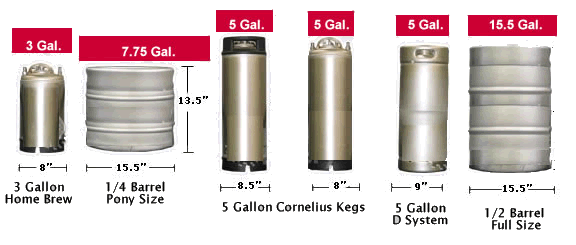Thejadeddog (talk | contribs) m (→Force Carbonating) |
Thejadeddog (talk | contribs) m |
||
| Line 28: | Line 28: | ||
Once the beer has been [[Racking|racked]] to the keg, the lid is then placed on the keg and pressure is applied to seat the lid, sealing the keg. If carbonating naturally the keg should be kept at room temperature (65 to 70 degrees F) before cooling to serving temperatures. Kegs that will be force carbonated should be cooled to serving temperatures immediately. | Once the beer has been [[Racking|racked]] to the keg, the lid is then placed on the keg and pressure is applied to seat the lid, sealing the keg. If carbonating naturally the keg should be kept at room temperature (65 to 70 degrees F) before cooling to serving temperatures. Kegs that will be force carbonated should be cooled to serving temperatures immediately. | ||
| − | ==Force Carbonating== | + | ===[[Force carbonation|Force Carbonating]]=== |
{{Main|Force carbonation}} | {{Main|Force carbonation}} | ||
Revision as of 17:11, 2 October 2007
Many homebrewers choose to keg their beer rather than bottle it. Kegging offers several advantages to bottling, such as reduced packaging time, faster carbonation time, more control over carbonation levels, and the ability to dispense just the right amount of beer. Kegging does require a greater up-front cost as well as additional equipment and space.
This article details some of the basics of kegging.
Contents
Equipment Needed
Several pieces of additional equipment are required to keg beer. At a minimum you will need some kegs (most home brewers use cornelius kegs), Beverage Lines, Quick Disconnects, and Picnic Taps or other means of dispensing your beer, and some way of keeping the kegs cold, typically a refrigerator or chest freezer (see kegerators).
Many home brewers choose to have more advanced kegging set-ups including a CO2 tank for force carbonating, gas lines, and a draft tower and faucets for dispensing.
Types of Kegs
There are several different types of kegs; however, most home brewers use cornelius kegs as they are easy to use and hold 5 gallons:

Other types of kegs include Sankey Kegs, Mini Kegs, and 1/2 barrel Commercial Kegs.
Buying kegs
Cornelius kegs are available new or used/refurbished. There is a significant price difference between new and used kegs; most home brewers choose to purchase used kegs that have been pressure tested and require minimal maintenance before being put into service.
Things to consider when purchasing used kegs include whether the keg has been pressure tested, whether the gaskets, seals, and valves need to be replaced, and whether the keg has been cleaned. Kegs that are ready for immediate service tend to be slightly more expensive than those that still require maintenance.
Kegging Process
The kegging process is fairly straightforward and considerable easier than bottling.
First the keg must be cleaned and sanitized. It is important that all parts of the keg are properly sanitized in order to prevent infection. Most home brewers break down their kegs (see Keg Maintenance in order to ensure proper sanitation.
Once the keg is cleaned, sanitized, and re-assembled, the beer is racked to the keg. Some home brewers prefer to "naturally" carbonate their kegs with priming sugar while other choose to force carbonate. These brewers must make a priming solution (just like when bottling) and add it to the keg prior to racking the beer. It should be noted that kegs require less sugar in the solution than bottles.
Once the beer has been racked to the keg, the lid is then placed on the keg and pressure is applied to seat the lid, sealing the keg. If carbonating naturally the keg should be kept at room temperature (65 to 70 degrees F) before cooling to serving temperatures. Kegs that will be force carbonated should be cooled to serving temperatures immediately.
Force Carbonating
{{ #if: | Main article: [[Force carbonation|]] | Main article: Force carbonation }}
Most home brewers choose to force carbonate their kegs in order to better control the carbonation level for a particular beer style and to carbonate their beer faster.
Storing Kegs
|
This section is a stub.
|
Kegerators
|
This section is a stub.
|
Building Your Kegerator
Check out Orpheus' instructions for converting a Sanyo 4912 mini-frige or Bobby M's video for converting a chest freezer into a kegerator:
Serving From a Keg
|
This section is a stub.
|
Keg Maintenance
|
This section is a stub.
|
